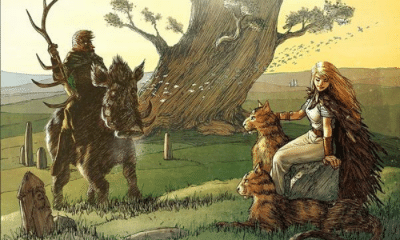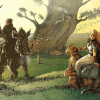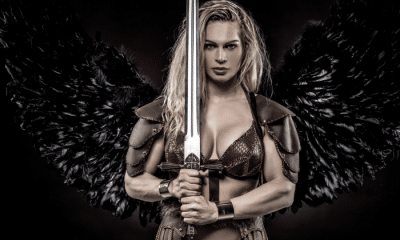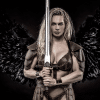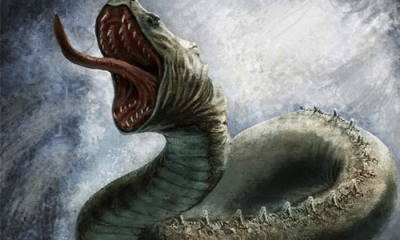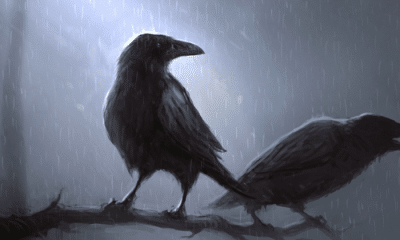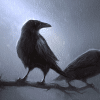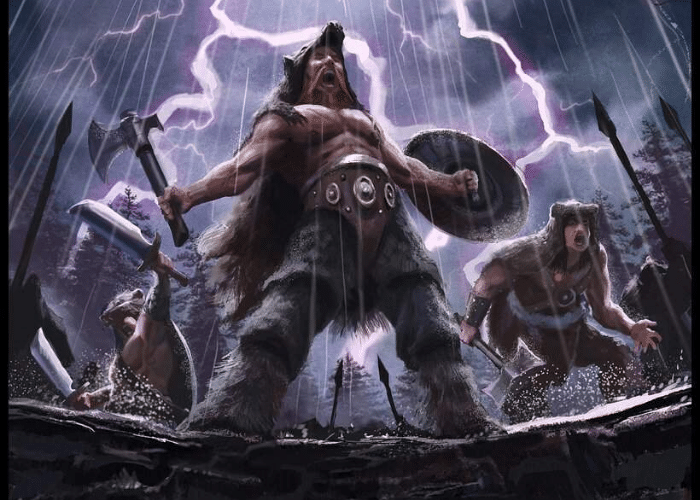
Norse
The Berserkers: The Crazed Warriors of the Vikings
The Berserkers: The Crazed Warriors of the Vikings
Nothing brought fear to the people of medieval Europe like the Viking raiders. Most terrifying of all were the berserkers, who used the powers of animals and the gods to destroy anyone and anything in sight!
For nearly two hundred years in the Middle Ages, Norse raiding parties struck terror into villages and monasteries from Ireland to Eastern Europe. Viking raiders made their way as far west as Canada and ventured into the Mediterranean and North Africa.
With their swift boats and ruthlessness, these raiders became the most feared men in all of Europe. Among them, however, were a few warriors who terrified even their companions.
The berserkers entered such a state of bloodthirsty frenzy that they risked attacking their own men in the heat of battle. Crediting the gods for their strength, their fury made them identify more with wild animals than the men they served alongside.
If a Viking raider could frighten the average person in medieval Europe, a berserker was almost unbelievably terrifying to face.
So who were these fur-clad warriors of the Viking Age?
The Fury of the Berserkers
The berserkers were the shock troops of a Viking Age raiding party.
While many men in the Norse world trained for battle and prided themselves on their skills, the berserkers stood apart as the most fearsome fighters known.
What made them so terrifying was that they completely abandoned training, strategy, and forethought in the heat of battle.
During a fight, the berserkers entered a state of absolute frenzy. They would shake, howl, and foam at the mouth as they gave in to absolute bloodlust.
The berserkers were sad to lose all thought and reason in this state, to the extent that they would attack their own comrades.
Despite this, however, the berserkers are said in sagas and historical accounts to have been elite soldiers who often served as royal bodyguards and champions of the kings.
Although they were unpredictable and uncontrollable, the berserkers were also said to have been incredible warriors. Their frenzy gave them strength beyond any other man and, according to some, made them impervious to iron and fire.
Berserkers were said to plow through enemy troops with no regard for their own safety and no thought other than destruction. While such single-minded violence may have been dangerous, it also made them highly effective.
Some historians believe that many warriors adopted the symbols of a berserker to increase their own notoriety, even if they did not enter the frenzied state that made a true berserker. The sight of a made dressed as one of the crazed fighters was sometimes enough to frighten an enemy into backing down or forgetting their training.
Berserkers were easy to spot on the battlefield for this very reason. Their distinctive appearance also helped their comrades to avoid straying too close to their battle frenzy.
Berserkers typically dressed in animal furs. The word comes from the Old Norse for “bear shirted.”
Legends claimed that some berserkers literally transformed into an animal in the heat of battle. It was said that they used claws and fangs to rip apart their enemies when they lost their conventional weapons.
Accounts from the Norse berserkers and other ancient cultures identified three primary animals that these fighters allied themselves with.
The most famous, and probably the most common, were the bear berserkers. In addition to their ferocity, they were also known to be exceptionally observant of religious rituals and rites.
The ulfhednar, or wolf warriors, were known in many cultures besides the Norse. Turks, Mongols, and some Native American tribes had similar warriors who took on the persona of a wolf in battle.
Finally, the svinfylking fought at the head of the army in a formation that mimicked a boar’s snout and tusks. They were said to be masters of stealth who used disguises and knowledge of the terrain to escape danger and infiltrate enemy camps.
The berserkers did not have the honor that distinguished the great heroes and kings of legends. However, they had other attributes that earned them praise on and off the battlefield.
My Modern Interpretation
In Norse culture, the berserkers did not take credit for the frenzy that inspired them to feats of strength. They were devoted followers of Odin and believed that their skills came from him.
Odin was not only a warrior god. He was also a god of magic who, it was believed, could inspire his followers to raptured states of religious ecstasy.
For a seer, such a state might be a trance in which they could peer into other worlds and decipher the threads of fate. For a warrior, however, Odin’s religious frenzy made them almost unstoppable fighters.
The berserkers were known to be observant followers of the gods, particularly Odin. In one saga, a berserker refused to engage in single combat unless the fight was postponed by three days so he could observe the Yule.
The rage of a berserker was a form of magic, granted by the gods in recognition of both skill and devotion. It was the masculine counterpart of the more well-known forms of magic in Norse lore.
Much of the magic that appeared in legends was seidr, which involved foretelling the future and manipulating destiny. Everything from prophesizing a great calamity to brewing a love potion fell into the realm of magic related to destiny.
While there were male practitioners of seidr, including Odin, it was generally regarded as a more feminine practice. The berserkers, however, had magical gifts that were entirely masculine.
This not only gave both sexes an acceptable and powerful form of magic, but it also balanced the character of Odin. Without his prowess in battle magic, his knowledge of seidr may have made him an overly feminine-seeming character.
Historians believe that the powers of the berserkers, however, far predicted the rites they kept in Odin’s name.
As seen with the wolf warriors, many cultures around the world had a tradition of men entering a battle rage in the guise of an animal. These animals not only embodied the fighter’s power and ferocity, but also his religious convictions as well.
Historians believe that the Germanic berserkers arose out of prehistoric traditions similar to those of other cultures. Like the Native Americans and Mongols, the animalistic warriors originated with early shamanic practices in the distant past.
Before the development of complex pantheons of human-like gods, many societies practiced animistic religions. Looking at the attributes of the natural world, fighters drew inspiration from the strength and power of animals like bears, boars, and wolves.
Many historians believe that the frenzy shamanic worshippers entered into may have been intentionally enhanced. Their mindlessness and courage could have been brought about by hallucinogenic or other drugs.
Others believe that berserkers may have suffered from mental trauma, possibly intentionally inflicted to bring about a state of mindless rage. The fatigue that was said to follow a berserker’s fury is reminiscent, according to some experts, of the effects of post-traumatic stress disorder.
Whether their rituals included drugs, mental illness, or an intentional hysteria, the berserkers and other traditional animal warriors were typically marked by their religious devotion. Their ceremonies, including chanting and drumming, likely helped to induce the mental state that made them exceptional fighters.
The Norse and other Germanic tribes likely inherited these traditions from early cults devoted to these animals. While the gods had changed in form, the practice of donning animal pelts and claiming the ferocity of a predator remained.
The gods themselves also retained some qualities of their early animal ancestors, as well. In Norse mythology, Odin kept two wolves at his side and Freyr rode in a chariot pulled by an enormous boar.
In the 10th century, a Byzantine king wrote that Norsemen in her personal guard performed a dance in which they dressed in animal skins and masks. While these elite Germanic soldiers may have been invoking Odin in the rites of the berserker, they were also likely reenacting religious rituals that had existed since the Stone Age.
In Summary
Norse sagas and historical accounts describe terrifying warriors known as berserkers. These fighters worked themselves into such a frenzy during battle that they performed legendary feats of strength and endurance.
The berserkers were dangerous because their battle rage could induce them to attack friends and ignore commands. But they were counted among the most elite warriors in the Germanic world because of their power and fearsome reputation.
In the Norse tradition, berserkers were those fighters who took on the traits of a bear in their fighting. Others, including wolf warriors and boar warriors, would wear the furs or kids o the animals that emulated to mark themselves out in battle.
The berserkers were also known for their devotion to the gods, specifically Odin. Their powers were thought to be a type of magic gifted to them in exchange for this devotion.
Odin was not the only god who granted his followers such powers, however. Similar traditions existed around the world, from Mongolia to North America.
Historians believe that the theme of animal warriors has its roots in prehistoric shamanic practices. Animistic religions in early human cultures passed on the tradition of a warrior being granted the powers of a bear, boar, wolf, or other predators.
The rituals that brought about the frenzied state of such a warrior likely changed little through the ages. They may have been enhanced by mental trauma or the use of drugs, but the ceremonies that gave berserkers the battle magic of Odin likely originated far before the god that the Viking Age berserkers revered.


